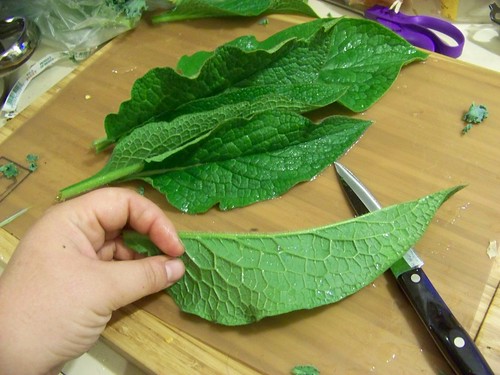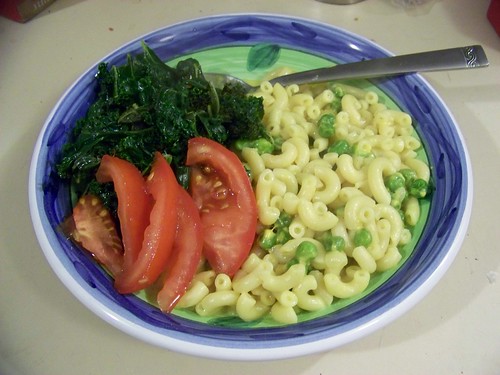I didn't grow up eating greens. Honestly, I'm still getting used to the idea. As a kid we occasionally had spinach, though usually as salads not as a cooked vegetable. These days my dad is known to cook some napa cabbage I'm pretty sure he never cooked collards or turnip greens for us. We probably wouldnt've eaten them.
 *Clean the kale and remove the leaves from the stem. Chop or tear the leaves into fork sized pieces. Heat a couple inches of water in a pan big enough to hold all of the kale. When it is boiling add the greens, stir a bit with a wooden spoon or tongs and cover. Let the kale steam a minute up to five then drain in a colander.
*Clean the kale and remove the leaves from the stem. Chop or tear the leaves into fork sized pieces. Heat a couple inches of water in a pan big enough to hold all of the kale. When it is boiling add the greens, stir a bit with a wooden spoon or tongs and cover. Let the kale steam a minute up to five then drain in a colander.
My first real introduction to greens came a number of years ago when I was working at a school with an organic garden. The woman who had planted the garden had planted about a dozen kale plants and they survived right through the winter. No one I worked with particularly liked kale and the plants were a bit aphid infested so we didn't want to donate them to the food bank. Being the poor AmeriCorps member that I was I decided to take these giant leaves home and see what to do with them.
the food bank. Being the poor AmeriCorps member that I was I decided to take these giant leaves home and see what to do with them.
 the food bank. Being the poor AmeriCorps member that I was I decided to take these giant leaves home and see what to do with them.
the food bank. Being the poor AmeriCorps member that I was I decided to take these giant leaves home and see what to do with them. I consulted my favorite source for basic cooking instructions - Cook's Illustrated. They recommended a steam sautee method where the greens are cooked over or in a small amount of water and then sauteed in flavored oil. Yeah, that's good stuff. Especially when that flavored oil is bacon grease.
Photo thanks to These Days In French Life
This method works particularly well for hearty greens like kale, collards and turnip greens. I prefer a simple sautee for tender greens like chard and beet greens.
Last year as I was learning about edible plants I kept running into a lot of plants referred to a potherbs. These are green plants who's leaves are best eaten cooked as opposed to salad greens. As some of these "potherbs" showed themselves this spring I realized it was time to learn to love greens.
Nettles and comfrey are two greens that grow abundantly in my neighborhood and have found their way into my kitchen recently. I experimented with nettles earlier this spring and love their flavor but hate having to deal with them. They taste minerally and are wonderful well salted. Last week I harvested some comfrey that I had scouted out last summer but hemmed and hawed over eating  at that time. Many sources note that comfrey contains chemicals called hepatoxic pyrrolizidine which can cause liver damage. Susun Weed speaks eloquently about how comfrey has gotten this, in her research and experience, undeserved reputation. The basic gist of Susun's article is that the toxic chemicals are found in the wild comfrey, not the cultivated one, and even then mostly in the roots and to a lesser degree in the stems and leaf ribs. The tipping point for me was when I saw comfrey listed in my Joy of Cooking as an eating green. Sauteed greens, here I come!
at that time. Many sources note that comfrey contains chemicals called hepatoxic pyrrolizidine which can cause liver damage. Susun Weed speaks eloquently about how comfrey has gotten this, in her research and experience, undeserved reputation. The basic gist of Susun's article is that the toxic chemicals are found in the wild comfrey, not the cultivated one, and even then mostly in the roots and to a lesser degree in the stems and leaf ribs. The tipping point for me was when I saw comfrey listed in my Joy of Cooking as an eating green. Sauteed greens, here I come!
 at that time. Many sources note that comfrey contains chemicals called hepatoxic pyrrolizidine which can cause liver damage. Susun Weed speaks eloquently about how comfrey has gotten this, in her research and experience, undeserved reputation. The basic gist of Susun's article is that the toxic chemicals are found in the wild comfrey, not the cultivated one, and even then mostly in the roots and to a lesser degree in the stems and leaf ribs. The tipping point for me was when I saw comfrey listed in my Joy of Cooking as an eating green. Sauteed greens, here I come!
at that time. Many sources note that comfrey contains chemicals called hepatoxic pyrrolizidine which can cause liver damage. Susun Weed speaks eloquently about how comfrey has gotten this, in her research and experience, undeserved reputation. The basic gist of Susun's article is that the toxic chemicals are found in the wild comfrey, not the cultivated one, and even then mostly in the roots and to a lesser degree in the stems and leaf ribs. The tipping point for me was when I saw comfrey listed in my Joy of Cooking as an eating green. Sauteed greens, here I come!Steam-Sauteed Hearty Greens
1 bunch of kale or collards or mustard greens or comfrey or a mix
2 cloves garlic, sliced
1 tbs bacon grease, or olive oil, or coconut oil
a shake of red pepper flakes
a pinch of salt
a dash of red wine vinegar
 *Clean the kale and remove the leaves from the stem. Chop or tear the leaves into fork sized pieces. Heat a couple inches of water in a pan big enough to hold all of the kale. When it is boiling add the greens, stir a bit with a wooden spoon or tongs and cover. Let the kale steam a minute up to five then drain in a colander.
*Clean the kale and remove the leaves from the stem. Chop or tear the leaves into fork sized pieces. Heat a couple inches of water in a pan big enough to hold all of the kale. When it is boiling add the greens, stir a bit with a wooden spoon or tongs and cover. Let the kale steam a minute up to five then drain in a colander. *While the kale is draining and drying a bit heat the fat in a sautee pan or wok. Add the garlic and red pepper and cook until the garlic is starting to brown a bit. Add the kale and toss and turn with tongs. Cook until the kale is fully incorporated with the flavored oil. Sprinkle with salt and then finish with vinegar.
I used the same steam-sautee method with the comfrey as I do with kale only made sure to cook it well in the water first. With kale I only steam it until it changes color but I made sure the comfrey was cooked through. I also made sure to harvest the smallest leaves I could find and remove all the ribs from the leaves. It was just a gut feeling, but I went with it. Wild vegetables are not terribly interested in you eating them, so it's best to treat them respectuflly. I sauteed it in refined coconut oil with some garlic and chipotle flakes. It was fantastic.
If you haven't grown to love greens yet start with chard. Chard is a sweet, tender little green with hardly any of the bitter flavors or odd texture other greens can have. Use plenty of garlic, bacon or other good cooking fat and a goodly splash of vinegar right at the end. You'll be enjoying greens and ready to move on to potherbs in no time. And if all else fails, eat them with macaroni and cheese. You can handle just about any vegetable mixed with macaroni and cheese.
sweet, tender little green with hardly any of the bitter flavors or odd texture other greens can have. Use plenty of garlic, bacon or other good cooking fat and a goodly splash of vinegar right at the end. You'll be enjoying greens and ready to move on to potherbs in no time. And if all else fails, eat them with macaroni and cheese. You can handle just about any vegetable mixed with macaroni and cheese.
 sweet, tender little green with hardly any of the bitter flavors or odd texture other greens can have. Use plenty of garlic, bacon or other good cooking fat and a goodly splash of vinegar right at the end. You'll be enjoying greens and ready to move on to potherbs in no time. And if all else fails, eat them with macaroni and cheese. You can handle just about any vegetable mixed with macaroni and cheese.
sweet, tender little green with hardly any of the bitter flavors or odd texture other greens can have. Use plenty of garlic, bacon or other good cooking fat and a goodly splash of vinegar right at the end. You'll be enjoying greens and ready to move on to potherbs in no time. And if all else fails, eat them with macaroni and cheese. You can handle just about any vegetable mixed with macaroni and cheese.For more great recipes and real food ideas check out the Real Food Wednesday blog carnival!

Alyss - this is great! And thanks for participating in Real Food Wednesday.
ReplyDeleteCan you do me a favor and link back to our carnival -- it's in the rules:
http://www.cheeseslave.com/real-food-wednesdays/
Thanks!
We LOVE greens and eat them every day (or close to it). I like them for breakfast served with fried eggs and fresh tomatoes.
ReplyDeleteI remember reading about in an old edition of Carla Emery's "Encyclopedia of Country Living" about how great comfrey was. Then in an older edition about how dangerous it is and how you should never eat it, and only use it externally. Luckily I figured out the truth a few years later. Its not that dangerous
ReplyDeleteGreat information! We have lots of comfrey around that we feed to our animals, but have never tried eating it ourselves. Now we will!
ReplyDelete